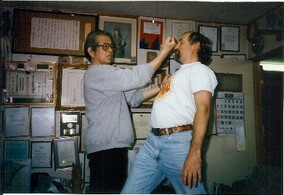
Surviving an Active Shooter Incident
10.12.18

There have been a number of these unfortunate events over the last few years. Virginia Tech, Columbine, the Denver movie theater, New Town, Connecticut and the US Navy Yard to name a few. Analysis of these events show that those who flee at the first sign of trouble are the most likely to survive. Those that can hide from the shooter are the next most likely to survive. Those that have to fight are in the 50/50 range of survival and those that are caught in place and give up are the least likely to survive.

The Department of Defense created mandatory training for employees that teaches to run first, hide (barricade yourself in) if you cant run and fight only if you absolutely have to. Emphasis is on assessing your situation thoroughly before anything happens and rehearsing what you would do in a number of scenarios. Augmenting the DoD course concept, below is our Shinken Taijutsu method for preparing for and surviving an Active Shooter incident.
- Learn the escape routes and available exits in all locations where you might find yourself should an Active Shooter incident happen while you are at work, restaurant, theater, department store, home or even stuck in traffic. These include knowing the back doors, emergency stairwells, fire escapes, windows with access to the outside, etc. You should never use an elevator to attempt to escape. It is too easy to become trapped if the power goes out due to a fire or explosion. Also what would you do if the elevator doors open and the shooter is standing right there waiting for you? Use the stairs farthest away from where you think the shooter that also has an exit nearby. Using stairs allows you to escape to another floor should the shooter enter the stairwell above or below you. [Note: Make sure you know which floors you can get back into should you use the stairs. Some buildings may not allow you to get back into certain floors.]
- What kinds of emergency communication do you have access to? Internal phone, intercom, radio, outside lines, your cell? Are their back up communications if the primary goes out with the power? Learn how to call for police and fire/rescue in each location. Do you have internal communications to a security response team in your bldg/organization or do you need to call 911 for outside help? Learn how to describe your location and the situation to responders. Know how to call your loved ones, friends, family, coworkers who may also be trapped in the situation. If you do not have access to communications where you are, learn where the closest comms are to you.
- Understanding the strength of your doors, locks and the surrounding walls of the area you are in. Are they strong enough to stop a determined attacker from getting inside? Is furniture or equipment available to strengthen the entry from access? Can you block the windows so the shooter cannot see inside and/or gain access? If you are in a weak location, figure out where you need to move to improve your defense should you have to stay and hide.
- Learn where the nearest help is located. Do you have an emergency operations center in your bldg? What about the security desk at the entrance? Is there a secure/safe room in your home or bldg? If you escape outside, can you get to your vehicle or is there a safe location nearby, such as a firehouse or police station? You should pick several rendezvous locations for your family or coworkers to egress to and regroup.
- Go over all of the above scenarios with your family and especially school-age children who may be more vulnerable and dependent on others for their safety. Learn what safety mechanisms your children’s schools have in place and incorporate them into your family’s training.
- Should you have to fight, what weapons or improvised weapons do you have at your disposal at work, in the car, at the theater, on you, etc. I am a big proponent of carrying a small clip knife, a metal writing pen (tactical pen) and a small flashlight at all times during the day and when I am out and about. [Note: Please seek professional training in the use of a clip knife, tactical pen and flashlight if you want to be effective in their use.] Assess what you have on your person or within arms reach in your home, office and car. Should you come face to face with an Active Shooter, what weapons do you have available to throw at your opponent or use against them? If you are forced to fight, do it with total commitment, because your life and the lives of others will depend on it. A half-hearted response against a determined attacker will turn out badly for you. Statistics bear out that a strong counter-attack weighs in your favor. This is true whether you are armed or not and going against an armed opponent. So go all out, don’t hold back, and don’t stop until you are safe. [Note: Seek professional training in personal defense if you want to better defend yourself and others.
These are some of the things you need to assess, rehearse and make a part of your life to give you the best chance possible of surviving an Active Shooter incident. You not only need to do this yourself, but engage your family and coworkers so everyone you care about has the best possible chance of getting through a bad situation.
So here is your homework assignment. Make an assessment of your place of work, home or other location where you spend a lot of time. Jot down the escape routes, safe locations, communications, strength of your defense and an idea of what improvised weapons you have available. Let me know what you come up with. Do this with determination and if you become involved in an Active Shooter incident, you will be the one to lead your friends, coworkers, loved ones and maybe even strangers to safety.
Gambatte !! Phil




